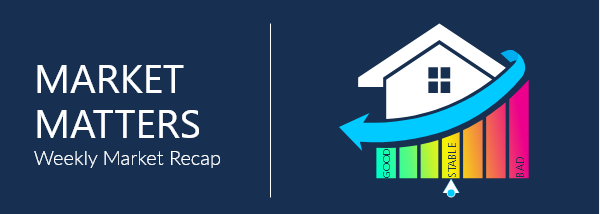Market Matters

This week we saw plenty of U.S. companies report Q1 earnings, giving investors a better idea on how much the economy contracted in the first quarter. As some states slowly start to lift their stay-in orders, the markets will keep a close eye to see how well those states perform opening up the economy. Spikes in cases of the coronavirus in those states may give other states ideas on how to open, while also spooking the market. Now that pandemic fears are waning, there are reports that President Trump may look to punish China in the form of new tariffs. This is not surprising, although will add additional uncertainty to an already cloudy economic picture.
 Jobless Claims
Jobless Claims
There were 3.839mln jobless claims filed in the week of April 25th, down by -603k from 4.442mln in the previous week, but more than the 3.5mln consensus. This week’s claims count is down 3.028mln from the peak of 6.867mln back in the week of March 28th. The 4-week moving average jumped to 13.3mln, an increase of 3.7mln from the previous week’s average. Continuing claims, which lag by a week, rose 2.174mln to a record 17.992mln. Topping off the data, the 6-week rolling total is now at 30.3mln jobless claims. Looking ahead, we will have another nonfarm payroll report out next week that is now likely to show at least a 15% unemployment rate, with a headline decline in payrolls anywhere from 2.0-2.5mln.
 Personal Income
Personal Income
Personal income fell by -2% in March, while personal spending declined by -7.5%. The decline in spending was the largest monthly decline on record dating all the way back to 1959. Both numbers combined caused the savings rate to spike to 13.1%, up over 5.1% from the prior read of 8%. It’s been since 1981 that households in the U.S. showed that kind of rate, although the effects of the Covid-19 pandemic obviously have played a part there. The PCE index rose 1.3% annually, down from 1.8% the month prior. Core PCE, which is the Fed’s measure of inflation, fell by -.1%, bringing the YoY rate down from 1.8% to 1.7%. Inflation pressures have eased, and the U.S. Commerce Department reported that the -.1% drop in core PCE seen in March was in-line with expectations. Fed Chair Powell voiced the belief yesterday that deflation will not occur because expectation of inflation is still widespread.
 Real GDP
Real GDP
Real GDP for Q1 in its advanced estimate showed a contraction of -4.8% versus -4% consensus. This is now the largest decline since Q4 2008, and the 8th largest decline on record. YoY, growth has slowed from +2.3% in Q4 2019 to just +.3% now. The biggest influence and surprise in Q1 data was the -7.6% drop in consumer spending, which makes up roughly 67% of GDP. Durable goods spending was down -16.1%, while spending on services were down by -10.2%. Business investment was very weak, down -8.6%, but residential investment, housing, was on fire, up +21%, which was the best quarter since Q4 2012. Finally, inflation measure was relatively low, with the GDP deflator up only +1.4%, with the core PCE up +1.8%. The Bureau of Economic Analysis commented saying, “The coronavirus lockdown led to rapid changes in demand, as businesses and schools switched to remote work or canceled operations, and consumers canceled, restricted, or redirected their spending. The full economic effects of the COVID-19 pandemic cannot be quantified in the GDP estimate for the first quarter of 2020 because the impacts are generally embedded in source data and cannot be separately identified.” Looking ahead, the report is likely to see further downward revisions ahead, with the Q2 GDP number significantly worse, some calling down as much as -30%.
 Consumer Confidence Index
Consumer Confidence Index
The Conference Board’s Consumer Confidence Index for April came in at 86.9, down -31.9 points and the lowest since June 2014 (86.4). This is down from the March read of 118.8 and has marked the largest one-month decline since December 1973. The present situation index, which is based on consumers’ assessment of current business and labor market conditions, fell from 166.7 to 76.4, however the expectations index, which shows the consumers’ short-term outlook for income, business, and labor markets conditions, improved to 93.8 from 86.8. “Consumer confidence weakened significantly in April, driven by a severe deterioration in current conditions," said Lynn Franco, Sr. Director of Economic Indicators at The Conference Board. "The 90-point drop in the Present Situation Index, the largest on record, reflects the sharp contraction in economic activity and surge in unemployment claims brought about by the COVID-19 crisis. Consumers' short-term expectations for the economy and labor market improved, likely prompted by the possibility that stay-at-home restrictions will loosen soon, along with a re-opening of the economy. However, consumers were less optimistic about their financial prospects and this could have repercussions for spending as the recovery takes hold. The uncertainty of the economic effects of COVID-19 will likely cause expectations to fluctuate in the months ahead."

